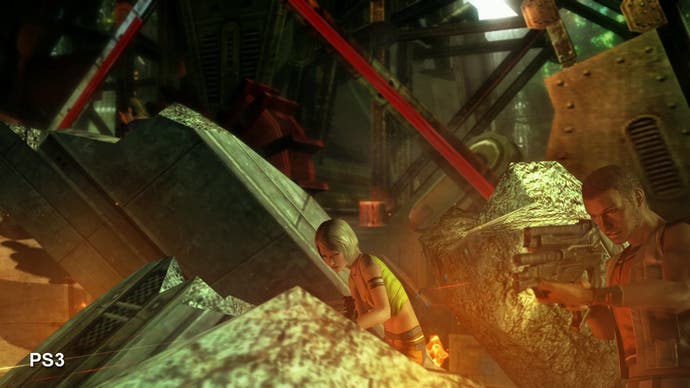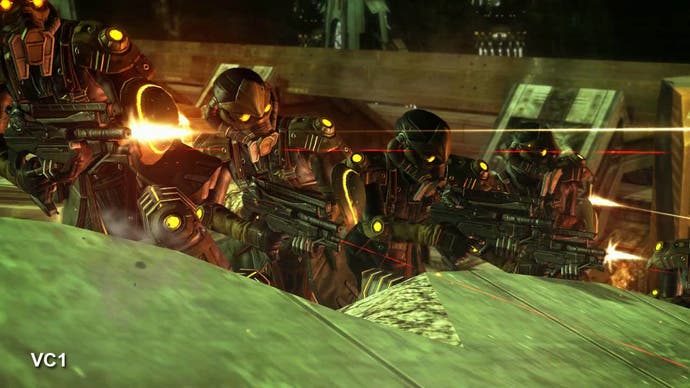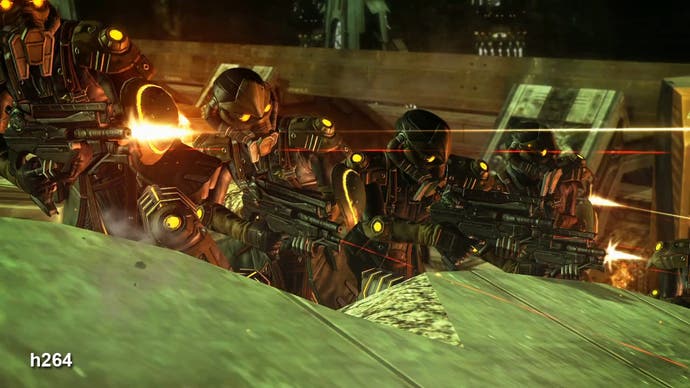Final Fantasy XIII: Endgame
Digital Foundry vs. FFXIII. The final analysis.
Relying on Bink for its 360 compression is probably one of the worst decisions made during the production of Xbox 360 FFXIII. It's an old compressor that hasn't transitioned well into the high-definition era and requires masses of bandwidth to process reasonable images.
Developers like it because they're used to it, memory requirements are low, it's fast and it's cross-platform. Encode a Bink file and it'll work on PC, 360 and PS3. Weirdly though, Bink is deployed only on the 360 SKU of FFXIII, with the component videos wrapped in a new container unique to Crystal Tools: multiple Binks exist within .wmp files.
Using our debug 360s, we ripped the .wmp files off each of the discs and extracted them into the component Bink videos using a tool of our own creation (which you can download from us). The idea was simple - rip the files, and see how much data we can extract from them: how much video there actually is, and the overall space available. Bink tools have been freely available to download for ages, meaning that our component videos can be analysed one at a time.
The results are enlightening. Here's an interesting table of facts, and for a complete breakdown of the videos on all three discs, check out this PDF we prepared. It shows the amount of video data per disc on Xbox 360, duration of each vid, and also reveals the average amount of bandwidth allocated. We can also see that in total, the game has three hours, 42 minutes of CG and pre-rendered cut-scene video.
| Disc | Number of Videos | Overall Duration | Average Bandwidth | FMV Data | Game Data | Empty Space |
|---|---|---|---|---|---|---|
| 1 | 32 | 01:07:37 | 7.26mbps | 3.29GB | 2.52GB | 0.99GB |
| 2 | 39 | 01:12:19 | 6.90mbps | 3.16GB | 2.58GB | 1.06GB |
| 3 | 31 | 01:22:48 | 7.15mbps | 3.34GB | 3.16GB | 0.30GB |
| Total | 102 | 03:42:45 | 7.10mbps | 9.79GB | 8.26GB | 2.35GB |
The bandwidth figures in particular are hugely revealing. Of course, they pale into insignificance compared with the PS3 version of FFXIII (they're about 30 per cent of the size), but consider this: BBC HD runs at around 9.7mbps for 1080p, YouTube gets by (just) with a mere 2mbps for its 720p HD. Well-encoded 720p at 7mbps should be pretty much pristine... so long as you use a decent encoder and codec.
Square's problem is that it didn't use a modern compression scheme. Not only does Bink fail to give decent-quality playback despite the surfeit of bandwidth, we were surprised to discover that the videos aren't even HD. Just like the 360 renderer itself, the videos run at 1024x576.
This should result in better compression quality but Bink simply can't cope, even at the lower resolution, resulting in the ugly macroblocks being upscaled, producing an even worse picture. Across the entirety of the three discs, only the title sequence and the introductory FMV get decent levels of bandwidth (15mbps - that's about equivalent to SkyHD's premium channels) and fast action still betrays obvious compression artifacts.
Quite why Square went with 576p for the video can be explained with two simple reasons: first of all, the game itself runs at that resolution on 360. FFXIII's cinematics (CG aside) are designed to blend seamlessly with the game. Secondly, it's clear that Bink has issues retaining image quality with the smaller resolution, so using the same bandwidth for full-on 720p simply wasn't an option.
Bearing in mind that the video sequences account for over 3.5 hours of the FFXIII experience, it's quite extraordinary that Square should go with a substandard off-the-shelf solution clearly not up to the task, especially bearing in mind that - as pointed out in the original Face-Off - Microsoft supports VC1 in the form of what's internally dubbed XMV, but is in actual fact a plain and simple WMV HD file. 7mbps is more than enough with WMV not only to support full 720p, but also eliminates many of the compression issues. Not pristine for sure, but clearly way in advance of the shipped game.
A more ambitious option would've been to implement an h264 decoder (renowned library CoreAVC even has a PPC port). There's a reason why virtually every major broadcaster in the world uses it, including YouTube (which, coincidentally gets 1080p video working with half the bandwidth of the 1024x576 FFXIII video files - 3.5mbps). Put simply it's the most efficient compressor around; it's why we use it here at Eurogamer over and above any other codec.
To illustrate, here's a comparison. On the top we have a shot from one of the worst video sequences seen in FFXIII on 360. Next to it is the nigh-on pristine PS3 version. On the bottom we see VC1 and h264 encodes, second generation versions based on the PS3 FMV. Note that the filesizes of our encodes are the same, or smaller, than the original Bink encodes in the shipping 360 title (presumably derived from the original CG sources).




Flash in the pan? No way, here's the same exercise repeated, this time with the "lightning" sequence from the first chapter. The lead female protagonist lives up to her name, but the resulting effect is horribly compromised with enormous macroblocking on the retail 360 version. With WMV and h264, we get a huge boost in resolution, and far higher image quality.




Our VC1 encoding experience isn't so hot, and while the improvement is palpable, it's not really in the same league as h264, where we lose very little in the transition to a much smaller filesize. That said, if retaining a consistent 576p is important in stitching together real-time cut-scenes with the FMV, VC1/WMV would easily have produced some excellent results: fewer pixels to encode means that the bandwidth goes a lot further. If you fancy getting a look at fully uncompressed versions of the shots, we've uploaded them for you.




Fancy seeing our h264 re-encodes to see what could have been? So long as you have a decent decoder for your PC (think: ffdshow or CoreAVC - not Quicktime) and a nice player like Media Player Classic, that's no problem. Grab the first clip through this link (mirrors). There's a bigger clip too and that has its own set of mirrors. Finally, all the sample files in this piece can also be located in one place.
So how can we approach the quality of the PS3 videos with a much smaller amount of data? Surely it's impossible to reduce videos to just a third of their original sizes and maintain anywhere near the same level of quality? Not quite. It's the nature of video compression that the more bandwidth you throw at it, the more the law of diminishing returns kicks in: tripling filesize doesn't equate to tripling of picture quality.
There's no denying that having 50GB storage at your disposal is immensely cool, so why not make full use of it, particularly if it means you get pristine quality video by default? It's the right call for PS3. But with 360, the reduction in available space simply means you need to work harder to get an equivalent effect.
Nobody's saying that the picture will be absolutely pristine in all cases (though let's remember that there's 2.2GB of space left to play with spread across the three 360 discs, and that certainly makes a difference), but the point is that the end result should have been a whole lot better - a sentiment that sums up much of our analysis of many of the tech elements of the game itself.
Thankfully we have reached a point where games like Bayonetta PS3 and FFXIII 360 are the exceptions rather than the rule. These are releases where the vast bulk of the developmental time was spent on just the one console, before the other was shoehorned into the schedule.
The market has changed, platform exclusives and your actual "lead" platforms are becoming increasingly rare, and the fact that even the big Japanese studios are now realising the worth of simultaneous release on both systems suggests that the working practises of other studios in developing on both platforms simultaneously will - hopefully - become the norm.
Thanks to Hotcooler and Alex Goh for the valuable assists in compiling this feature.








